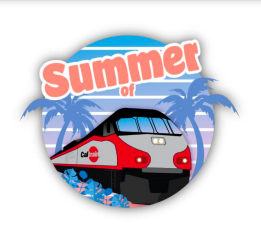Caltrain is rolling out marketing plans to regrow transit ridership after steep pandemic declines. The strategies encourage people to take the train for more kinds of trips and for current commute patterns.
Coasters at bars encouraging people to have fun safely with a train as the designated driver. Family and group day passes making excursions more convenient (these will be available on Caltrain’s mobile app and ticket vending machines)Promotions around events and attractions you can get to using the trainMarketing campaigns for people who use bikes and scooters to get to and from Caltrain – currently at the highest level in historyThree-day passes addressing the needs of commuters who come into work several days a week (but the days they have to be consecutive)Promotions building excitement around the upcoming electric train service next fall
Looking forward toward 2024, there will be more opportunities for marketing with the next-generation Clipper that will support Open Payment – the ability to use credit and debit cards, and Apple and Google Pay to pay for transit. This will open the door to promote transit for impulse trips and trips for travellers.
Car-free access – walking, bicycling, transit
These days a majority report that they did not have access to a car for their train trip.
As part of this trend, Caltrain is seeing record-high use of bikes and scooters for their first and last mile (nearly 20%).
Also supporting people who drive less, Caltrain is participating in the regional pilot for free and reduced price transfers, which will improve convenience and affordability for people using other transit to get to/from the train (14-15% of riders in 2022). Caltrain is anticipating about a 5% increase in ridership (slide 10) with the free transfer pilot rolling out in 2024 with the next-generation Clipper system.
The free transfers will be all the more beneficial for low-income travellers who are more likely to use other transit to connect to and from their destination.
Building on this direction, Caltrain will be starting a Joint Regional Rail Fare Study with BART that could result in standardizing regional fares (slides 4 and 5), along the lines of the recommendation of the Fare Coordination and Integration Study in 2021. That study modeled the standardization of regional fares, starting with BART and Caltrain, to generate as many new riders for the regional system as another Caltrain.
However, Caltrain is holding off on this study until the fall of 2024, after the launch of Clipper 2.0 that will have better data. We wonder why Caltrain is being so cautious, given the very promising results of the 2021 study and the existential importance of regrowing transit ridership.
Caltrain is being even more cautious regarding the regional initiative for an all-agency transit pass. The first phase of the BayPass pilot is showing a 35% transit ridership increase among riders who previously had a single-agency pass.
Caltrain is working with MTC, BART and other agencies in nailing down the details on the next phase of the pilot, expected to include tens of thousands of riders at employers and transportation management associations. BayPass is particularly promising for Caltrain serving cities and institutions in locations that depend on multiple agencies. In San Francisco and San Jose, Caltrain will be a meaningful but relatively small slice of overall transit depend.
Caltrain’s plans for passes include many strategies for the BayPass, and no indication that it is considering BayPass as part of a long-term strategy for institutional fares. Focusing on the Go Pass in the near term is appropriate – after all, the Go Pass exists, and there is no multi-agency institutional product that is widely available in 2023 and 2024. However, the region is clearly looking at multi-agency passes as the future, and these have major potential benefits overall transit use in the region including Caltrain.
Caltrain’s strategy in working with cities on transportation demand management policies mentions only the Go Pass. This appears strange from the perspective of cities, whose policies are in place for years. Cities will benefit from multi-agency passes for employers, residential developments, and other institutions serving people who need multiple transit services, not just Caltrain.
Single brand focus
While Caltrain is supporting free transfers and participating in the development of BayPass, its marketing is focusing heavily on the Caltrain brand. The current wave of promotions is branded “Summer of Caltrain.” The agency is clearly proud of its positive brand image.
But in promoting “Destination Caltrain” the agency is missing out on destinations that people can take with Caltrain with additional services. In the Citizens’ Advisory Committee meeting reviewing the marketing plans, members mentioned multiple examples of trips with Caltrain, including the farmers market at the Ferry building, speakers at the Commonwealth Club, and concerts at Levi’s Stadium – which require a last-mile connection. One member mentioned all the trips his family takes to destinations advertised with the BARTable promotions from the other major brand in the regional rail system.
The rail agencies could take a page from the upcoming Bay Area Transit Month festivities in promoting destinations accessible via transit, rather than a primary focus on which agency.

